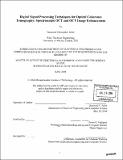| dc.contributor.advisor | James G. Fujimoto. | en_US |
| dc.contributor.author | Adler, Desmond Christopher, 1978- | en_US |
| dc.contributor.other | Massachusetts Institute of Technology. Dept. of Electrical Engineering and Computer Science. | en_US |
| dc.date.accessioned | 2005-09-26T20:42:56Z | |
| dc.date.available | 2005-09-26T20:42:56Z | |
| dc.date.copyright | 2004 | en_US |
| dc.date.issued | 2004 | en_US |
| dc.identifier.uri | http://hdl.handle.net/1721.1/28486 | |
| dc.description | Thesis (S.M.)--Massachusetts Institute of Technology, Dept. of Electrical Engineering and Computer Science, 2004. | en_US |
| dc.description | Includes bibliographical references (p. 132-135). | en_US |
| dc.description.abstract | Digital signal processing (DSP) techniques were developed to improve the flexibility, functionality, and image quality of ultrahigh resolution optical coherence tomography (OCT) systems. To reduce the dependence of OCT research systems on fixed analog electronics and to improve overall system flexibility, a digital demodulation scheme implemented entirely in software was developed. This improvement allowed rapid reconfiguration of the OCT imaging speed and source center wavelength without having to construct new analog filters and demodulators. This demodulation scheme produced a highly accurate envelope and was immune to local variations in carrier frequency. To provide an alternative contrast modality to conventional intensity-based OCT imaging, spectroscopic OCT technology was investigated. Preliminary studies on animal models were carried out, with the ultimate goal of enabling the early detection of dysplastic lesions in epithelial tissue through spectroscopic changes not visible with conventional OCT. Various spectral analysis techniques were investigated and evaluated for their ability to provide enhanced contrast of specific tissue types. Areas of concern such as red-shifting of the spectrum with increasing imaging depth, Doppler shifts induced by the optical path length scanner, and determination of an optimal spectroscopic metric were addressed. To improve the quality of ultrahigh resolution OCT images, wavelet processing techniques for speckle noise reduction were investigated. Spatially adaptive wavelet denoising techniques were compared to basic wavelet denoising techniques and time domain filtering. By using a set of image quality metrics, it was possible to quantify the effectiveness of the various filtering methods and determine an optimal | en_US |
| dc.description.abstract | (cont.) process for removing speckle noise while maintaining feature sharpness. | en_US |
| dc.description.statementofresponsibility | by Desmond Christopher Adler. | en_US |
| dc.format.extent | 135 p. | en_US |
| dc.format.extent | 7603090 bytes | |
| dc.format.extent | 7620071 bytes | |
| dc.format.mimetype | application/pdf | |
| dc.format.mimetype | application/pdf | |
| dc.language.iso | en_US | |
| dc.publisher | Massachusetts Institute of Technology | en_US |
| dc.rights | M.I.T. theses are protected by copyright. They may be viewed from this source for any purpose, but reproduction or distribution in any format is prohibited without written permission. See provided URL for inquiries about permission. | en_US |
| dc.rights.uri | http://dspace.mit.edu/handle/1721.1/7582 | |
| dc.subject | Electrical Engineering and Computer Science. | en_US |
| dc.title | Digital signal processing techniques for optical coherence tomography : OCT and OCT image enhancement | en_US |
| dc.title.alternative | DSP techniques for optical coherence tomography | en_US |
| dc.type | Thesis | en_US |
| dc.description.degree | S.M. | en_US |
| dc.contributor.department | Massachusetts Institute of Technology. Department of Electrical Engineering and Computer Science | |
| dc.identifier.oclc | 57253494 | en_US |
